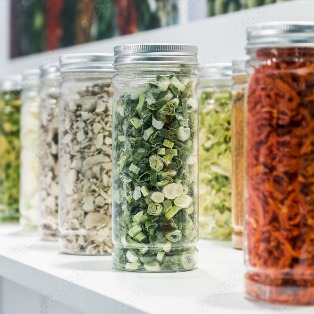Table of Contents
Freeze-Drying in Food Processing: Enhancing Quality, Shelf Life & Profitability

Freeze-drying, or lyophilization, is transforming the food industry by merging cutting-edge technology with consumer demand for premium, nutritious, and sustainable products. From preserving delicate probiotics to enabling global export of perishables, this process addresses critical challenges while unlocking new market opportunities. Here’s how freeze-drying is reshaping food manufacturing—and why it’s worth the investment.
Why Freeze-Drying is Revolutionizing Food Manufacturing
Industry Challenges Addressed
Nutrient Preservation:
Retains 95–98% of heat-sensitive vitamins (e.g., vitamin C in strawberries), enzymes, and probiotics.
Ideal for organic and functional foods where nutrient integrity is a selling point.
Microbial Safety:
Eliminates pathogens like Salmonella and E. coli without high-temperature pasteurization, which can degrade quality.
Waste Reduction:
Extends shelf life to 2–25 years, reducing spoilage losses and enabling surplus upcycling (e.g., “ugly” produce into powders).
Key Advantages for Processors
Premium Positioning: Commands 3–5x price premiums over dehydrated goods.
Export Flexibility: No refrigeration needed—ship freeze-dried mangoes to Asia or Europe without cold chain costs.
Clean-Label Appeal: No synthetic preservatives required, aligning with non-GMO and organic trends.
Top Commercial Freeze-Drying Applications
| Food Category | Process Benefits | Example Products |
|---|---|---|
| Dairy & Alternatives | Preserves live probiotics | Instant kefir powder, vegan cheese crisps |
| Fruits & Vegetables | Locks in color and phytochemicals | Starbucks’ berry inclusions, soup base mixes |
| Meat & Seafood | Lightweight, high-protein | Astronaut meals, emergency chicken strips |
| Ready-to-Eat Meals | Rehydrates in 5 minutes | Backpacker’s Pantry risotto, military MREs |
| Beverage Ingredients | Enhances solubility and aroma | Instant coffee, matcha powder, cocktail herbs |
Innovation Spotlight: Coca-Cola uses freeze-dried citrus zest in premium drink mixes for vibrant flavor.
Freeze-Drying vs. Traditional Food Processing Methods
| Parameter | Freeze-Drying | Spray-Drying | Air-Drying |
|---|---|---|---|
| Nutrient Retention | 95–98% | 60–70% | 40–50% |
| Processing Time | 24–48 hours | 2–4 hours | 8–72 hours |
| Energy Cost | High upfront | Moderate | Low |
| Output Quality | Porous, quick-rehydrating texture | Dense, clumpy particles | Tough, leathery texture |
Key Takeaway: Freeze-drying excels for high-value, nutrient-dense products, while spray-drying suits cost-sensitive bulk items like milk powder.
Step-by-Step Industrial Freeze-Drying Process
Raw Material Prep:
Blanch vegetables to deactivate enzymes; flash-freeze berries at -40°C.
Loading:
Spread product on trays; industrial units handle 20+ tons daily.
Primary Drying:
Sublimate ice at -50°C under vacuum (0.01–0.03 mBar).
Secondary Drying:
Gradually heat to 30°C to remove bound moisture (<1% residual).
Packaging:
Use nitrogen-flushed Mylar bags to prevent oxidation.
Cost Analysis & ROI for Manufacturers
Investment & Savings
Equipment:
Small-scale: 100,000–500,000 (1–5 tons/day).
Industrial: $1M+ (20+ tons/day).
Operational Savings:
80% lower cold storage costs vs. frozen goods.
50% reduced transport weight (e.g., 100 kg strawberries → 10 kg freeze-dried).
Market Premiums:
Freeze-dried blueberries sell for 50/kgvs.15/kg for air-dried.
ROI Case Study: A mid-sized processor recouped costs in 3 years by shifting 30% of its berry line to freeze-dried exports.
Emerging Innovations in Food Industry Lyophilization
Hybrid Technologies:
Infuse freeze-dried fruits with CBD/THC for functional snacks.
Waste Reduction:
Upcycle imperfect produce into soup powders or smoothie mixes.
Automation:
AI sensors optimize drying cycles, cutting energy use by 20%.
Example: Nestlé uses AI-driven freeze dryers to produce Nescafe Gold, ensuring consistent solubility and flavor.
FAQ – Food Processing Professionals Ask
Q: Can freeze-drying replace canning?
A: For high-margin items like gourmet soups or organic fruits—yes. For staples like corn, canning remains cost-effective.
Q: What’s the minimum batch size for profitability?
A: 500 kg+ per run. Economies of scale are critical due to high energy costs.
Q: How to prevent flavor loss during processing?
A: Pre-treat with edible coatings (e.g., maltodextrin) or encapsulate volatile compounds.
Q: Is freeze-dried food suitable for gluten-free lines?
A: Yes—naturally gluten-free, but ensure dedicated equipment to avoid cross-contamination.
Final Thoughts
Freeze-drying is no longer a niche technology—it’s a strategic asset for forward-thinking food manufacturers. By enhancing product quality, extending shelf life, and tapping into premium markets, it offers a compelling ROI despite upfront costs. As automation and sustainability innovations evolve, lyophilization will continue to drive profitability and consumer satisfaction in the global food industry.
